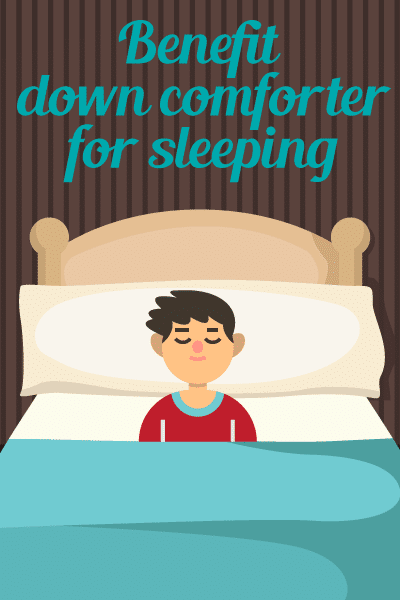We have all been there. You go to sleep at nine and your definition of what is to warm might be your partner’s definition of being too cold. But how exactly does this happen? Even though you may be under the same comforter, it’s very seldom that two people can agree on the same temperature when it comes to going to bed at night.
People have different levels of resistance against cold. One person might find 60 degrees quite warm while another person might find it a bit cold. These differences were categorized into different warmth levels in the down comforter industry. These warmth levels were defined by fill power. In other words, the amount of fill power determines which warmth level category a certain down comforter belongs.
To help you find the correct down comforter warmth, you need to consider 3 factors: your body’s tolerance, the room’s temperature, and the down comforter’s warmth level.
1. Body Tolerance
When it comes to a comfortable temperature, everybody has a different tolerance. What might be hot for one person may not necessarily be hot for another.
There are three types of people: warm sleeper, cold sleeper, and average sleeper.
People who are warm sleepers usually finds it uncomfortable under the blanket within an average room temperature (about 60 degrees). They usually throw the blanket off even at night.
Cold sleepers, on the other hand, is the complete opposite of warm sleepers. They usually go for an extra blanket in an average room temperature.
Average sleepers neither throw off the blanket nor add an extra blanket at room temperature of 60 degrees.
When the season changes, and the temperature in your home changes, you are more likely to see and feel the effects of what type of sleep for you are and the temperature that you prefer. Most people, however, typically have a general understanding of what their preferred temperature is.
2. Room’s Temperature
When it comes to down comforters, there are 5 room temperatures that are notetaking (all in Fahrenheit): above 70 degrees, 65 to 70 degrees, 60 to 65 degrees, 55 to 60 degrees, and below 55 degrees.
70° and up refer to room temperatures during the summer season. 65° to 70° refer to air conditioned room during summer while 60° to 65° refer to normal room temperature during non-summer and non-winter seasons. Early spring and late fall temperatures fall in here as well.
55° to 60° refer to most winter nights while room temperature below 60° refers to the coldest nights and extremely cold places such as Antarctica.
3. Warmth Level
There are 5 warmth levels to choose from:
- Ultra-Light
- Light
- Medium / Average
- Warm
- Ultra-Warm
Warmth level is affected by a couple of factors such as fill power, fabric, and thread count. Ultra-light warmth level features down comforters with lowest fill power and thread count while the ultra-warm, on the other hand, has the highest.
Thread count determines how much material the down comforter can take. Higher thread count means heavier material. Hence, more insulation can be put to the comforter in order to provide more warmth. The same logic goes with the fill power. The higher the fill power means that the comforter has a larger cluster of down. This greatly affects the overall warmth level of the down comforter.
Considering All Factors
To help you determine which warmth level to choose, let me show you what warmth level is appropriate for specific room temperature while considering the body tolerance against the cold.
Cold sleepers can either go for ultra-light or light warmth down comforters for a room temperature of 70° and up. Both warm and average sleepers should go for ultra-light down comforters.
In room temperature of 65° to 70°, warm sleepers should still go for ultra-light. Average sleepers can either go for ultra-light or light comforters. Cold sleepers may opt to choose between light down comforters and medium warmth comforters.
For 60° to 65° room temperature, average sleepers should go for medium warmth comforters. Warm sleepers should choose light warmth down comforters while cold sleepers should opt to get warm down comforters.
Warm sleepers can either choose medium warmth or warm down comforters within room temperature of 55° to 60°. Cold sleepers may choose between warm and ultra-warm while average sleepers will find enough comfort and warmth under warm down comforters.
At below 55° room temperature, cold sleepers should be able to find warmth under ultra-warm down comforters. Average sleepers can either choose warm or ultra-warm comforters while warm sleepers should have enough comfort under warm down comforters.
Know which type of tolerance do you have against the cold, then determine the room temperature of your bedroom. Defining these two factors will help you choose the perfect warmth level you need.
Final Thoughts
When it comes to going to bed, knowing the type of sleeper you are and the temperatures you prefer can be the difference between having a good night’s rest and waking up tired and unsettled.
We hope that this article has helped you figure out or at least identify what type of sleeper you are and the temperature that you prefer. Don’t forget to comment below and share your thoughts with us about what type of sleeper you are.
If you know someone who might find this article interesting, don’t forget to share it with them as well. Here’s to comfortable sleeping at the right temperature!















Leave a Reply